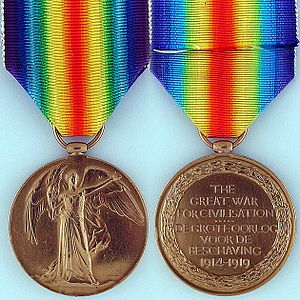Victory Medal (South Africa)
| Victory Medal (South Africa) | |
|---|---|
 |
|
| Awarded by the Monarch of the United Kingdom and the British Dominions, and Emperor of India | |
| Country |
|
| Type | Military Campaign medal |
| Eligibility | South African forces |
| Awarded for | Campaign service |
| Campaign(s) | First World War, 1914–1919 |
| Statistics | |
| Established | 1919 |
| First awarded | 1919 |
| Total awarded | Approximately 75,000 |
| South African order of wear | |
| Next (higher) |
|
| Next (lower) |
|
| Related |
|
|
Ribbon bars without and with MID emblem |
|
The Victory Medal (South Africa) is the Union of South Africa's version of the Victory Medal (United Kingdom), a First World War campaign medal of Britain and her colonies and dominions. The medal, never awarded singly, was awarded to all those South Africans who were awarded the 1914–15 Star, or to all those who were awarded the British War Medal. The set of three medals were irreverently nicknamed "Pip, Squeak and Wilfred". In the case of those who were not awarded either Star and only the British War Medal and Victory Medal, the pair was referred to as "Mutt and Jeff".
The Victory Medal, also known as the Inter-Allied Victory Medal, was instituted to celebrate the Allied victory in the Great War, in accordance with a decision of the Inter-Allied Peace Conference which preceded the Treaty of Versailles. The common award was first proposed by French marshal Ferdinand Foch, supreme commander of the Allied Forces during the war.
The same ribbon and variations of the basic medal design were adopted by Belgium, Brazil, Cuba, Czechoslovakia, France, Greece, Italy, Japan, Poland, Portugal, Romania, Siam, South Africa, the United Kingdom and her colonies and dominions and the United States of America. Most of the medals depict the Winged Victory, a female winged figure representing Nike, the mythological Greek goddess of victory. A particular form of the historic Greek monument to Nike or her Roman equivalent Victoria was chosen by each nation for its version of the medal, except by Japan and Siam, where the concept of a winged victory was not culturally relevant. The years of the war were shown as 1914 to 1918 in every case, except on the two medal versions of the British Empire, which show the years 1914 to 1919.
...
Wikipedia
